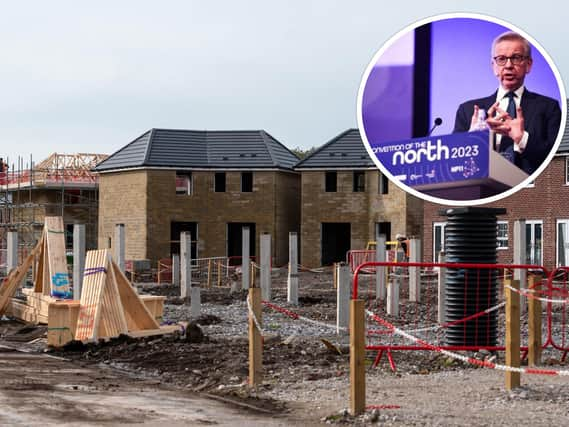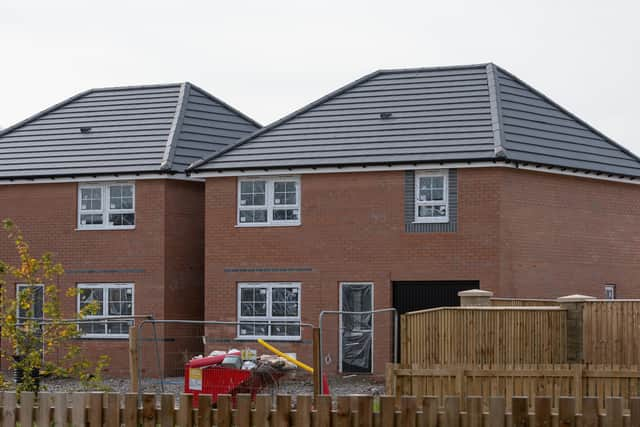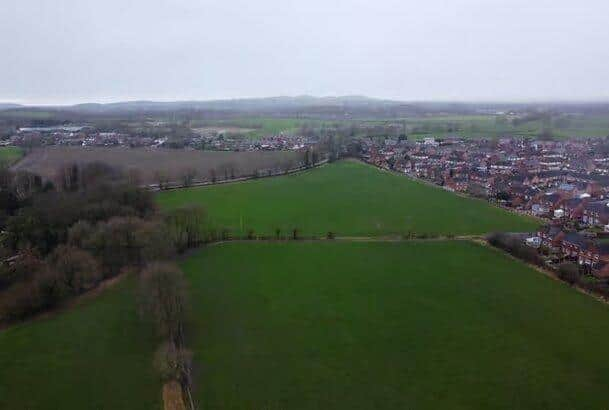Fury in Chorley as government allows builders to bypass council over new homes permission


In a speech delivered shortly before Christmas, the Levelling Up, Housing and Communities Secretary, Michael Gove, said that he was taking action against the council because too many of its planning decisions had later been overturned on appeal.
Having been “designated” for what the Secretary of State described as “poor quality decision-making”, Chorley will now be obliged to draw up an improvement plan.
Advertisement
Hide AdAdvertisement
Hide AdIn the meantime, however, housebuilders will have the option of bypassing the borough authority altogether and taking their applications for new homes directly to the Planning Inspectorate – the same body that hears the appeals of which Chorley has lost too many for the government’s liking.


Council leader Alistair Bradley told the Lancashire Post that if the government wanted councillors on Chorley’s cross-party planning committee to unquestionably approve every application brought before them, then “they might as well just replace us with some AI computer”.
He said he was hopeful that developers already operating in the area would still choose to lodge an application with the council in the first instance, because the local knowledge of the authority’s officers and residents at that stage in the process helped firms weed out any issues that they might face later on.
However, Cllr Bradley admitted he was concerned about the prospect of “speculative development by people who are just looking to take advantage of a situation created unnecessarily by the government “
Advertisement
Hide AdAdvertisement
Hide Ad“The benefit of good planning is that residents are involved and help shape their local area. They can say we might not like [this proposed] development, but we’d like you to do this, this and this – and that’s the way it should be,” the Labour leader added.


The designation by Mr. Gove comes after Chorley Council exceeded the 10 percent threshold set by the government, representing the maximum proportion of appeals by applicants against refusals of planning permission that should succeed in an area over a two-year period.
In the 24 months to September 2022, seven out of the 45 major planning decisions taken by the district authority were either overturned on appeal or went to the Planning Inspectorate because they were not determined by the council in the required timeframe. That is a reversal rate of 15.6 percent – the second worst in England, where the national average was just 2.2 percent.
The Secretary of State said in his speech on housing that he was acting “to deal with…planning authorities that have persistently under-performed in dealing with planning applications” and continuing his quest “to root out torpor” amongst local councils.
Advertisement
Hide AdAdvertisement
Hide AdHowever, Cllr Bradley accused the Department for Levelling Up, Housing and Communities (DLUHC) of failing to engage with the council over the issue for almost six months.


He said that a letter sent to the government back in July – in which Chorley had attempted to enter into a dialogue over ministerial concerns that had been raised about the rate at which planning appeals were succeeding – had gone unanswered until the day that the authority was also informed that it was being designated, which was the last parliamentary sitting day before Christmas.
“It was basically your 4.30-on-a Friday email where you are given bad news by somebody who doesn’t want it to be at a time when you can try to do something about it,” Cllr Bradley said.
The DLUHC was approached for comment about all the issues raised in this report, but did not provide one.
Advertisement
Hide AdAdvertisement
Hide AdHOW DID WE GET HERE?
Michael Gove’s designation of Chorley Council is the latest twist in a four-year planning system saga revolving around how many homes should be built in each part of Central Lancashire.
Chorley, Preston and South Ribble councils have co-operated over housing numbers across their collective patch for more than a decade, with the aim of ensuring that development is appropriately distributed according to the needs of each area and their capacity to accommodate new estates.
However, as the Post has documented, recent years saw the arrangement become bogged down by a series of appeals by housebuilders against decisions to refuse individual developments, the outcomes of which have often been based on differing interpretations of how housing figures should be calculated in each of the three districts.
The decisions – taken by independent planning inspectors – regularly had a ripple effect across the wider area. The increasingly circular situation meant that when Preston and South Ribble were told they could build fewer homes, Chorley was ordered to increase its share of development.
Advertisement
Hide AdAdvertisement
Hide AdIt seemed like the trio were on a never-ending merry-go-round of conflicting rulings. Unfortunately for Chorley, the music metaphorically stopped with a series of Planning Inspectorate decisions in early 2022 which saw the borough’s argument that its annual new housing requirement should be reduced – because of the inflated number of dwellings delivered in the district in the 2010s as part of the creation of Buckshaw Village – rejected.
Chorley unsuccessfully made that case at appeals including those against its planning committee’s refusal of permission for a 123-home estate off Blainscough Lane in Coppull and for 80 homes on Tincklers Lane in Eccleston – the latter having been an indicative refusal because the developer had already appealed to the Planning Inspectorate after the council had failed to reach a decision within the required time limit.
The assessment of the planning inspector who considered the Eccleston application was that the minimum 109 homes per year that Chorley had argued it should have to build for the remaining years of its current local plan would be an ”artificially low” tally.
She also concluded that the Central Lancashire-wide agreement on which it was based was out of date and that a new method of calculation introduced by the government in 2018 should be used instead. That pushed Chorley’s annual new housing need up to 569 dwellings – and, in double whammy, also rendered it unable to show that it had a five-year supply of land available to meet such a target, as required by government rules.
Advertisement
Hide AdAdvertisement
Hide AdThe result of that scenario was that council was then obliged to approve development even on “safeguarded land” – plots that are supposed to be protected for the duration of the existing local plan period through until 2026 – unless the harm caused by doing so “significantly and demonstrably outweighed the benefits” of meeting its deemed housing needs.
The authority successfully deployed that argument when its rejection of a 250-home development on Town Lane in Whittle-le-Woods was upheld by a planning inspector who shared the council’s concerns over issues including the impact of the site on local roads.
‘COMPUTER SAYS NO – BUT GOVERNMENT SAY YES?’
Cllr Bradley told the Post that Chorley Council had been discussing the planning situation with ministers for around two years until communication stopped in the summer. The authority had even met Mr. Gove himself back in January, who advised of a forthcoming change to the system under a revised National Planning Policy Framework (NPPF).
“He basically said, ‘I’m not going to change the rules for Chorley, but the rules are going to move towards where you want [them]to be’,” Cllr Bradley explained. When we got the consultation on the NPPF, it [addressed] a lot of the stuff that we had been complaining about.
Advertisement
Hide AdAdvertisement
Hide Ad“So we’ve carried on in that vein and then they wrote to us in July and said we were in danger of exceeding target levels [on decisions being overturned on appeal].”
He added that the problem the authority faces with the government requirement to produce an improvement plan is that it presumes there is a specific problem to be resolved. Latest figures show that Chorley delivered 1,175 new homes between 2019 and 2022 – nine percent above its minimum new housing need over that period.
“In my view, it’s not like our planning committee have not understood all the requirements of them [when they have refused applications that have later been overturned by inspectors]. They’ve just placed a different priority [on] the evidence available, which is not what the government appears to want.
“So are they going to take the powers off us and say ‘yes’ to every major planning application in Chorley? If they want to do that, then they can account to the people of Chorley.
Advertisement
Hide AdAdvertisement
Hide Ad“We’ve basically been kicked in the teeth for something we can’t actually control. The government appears to be agreeing with the developers in saying that no matter how bad the application is, because you haven’t got a five-year supply [of housing land], anything goes. It’s very much, ‘Computer says no’.
“We will work with the government to get us out of this situation, [but they] don’t appear to want to engage in a serious manner – they just want to make an example of somebody, Cllr Bradley said.
He also noted that there were ten other authorities that had breached the 10 percent appeals threshold, but Chorley was one of only two that was sanctioned.
The government’s own guidelines state that “exceptional circumstances” can be taken into account when considering whether to designate a council over the quality of its planning decisions.
Advertisement
Hide AdAdvertisement
Hide AdWHAT HAPPENS NOW?
While Chorley, Preston and South Ribble councils have co-operated over the distribution of new housing across Central Lancashire for more than a decade, they have maintained individual local plans that guide development in their own area.
However, that is set to change upon completion of the first joint local plan for the wider patch, work on which has been ongoing for five years.
The finished policy document will reset the three-way agreement over housebuilding numbers in each council area, after its previous iterations were unpicked by inspectors at various appeals since 2020.
A draft version of the plan has proposed a distribution that would weight development during the first four years of the new local plan period – 2023-27 – away from Chorley, which would be required to deliver 334 properties annually, compared to 600 in Preston and 400 in South Ribble.
Advertisement
Hide AdAdvertisement
Hide AdThat split was suggested in acknowledgement of the fact that the majority – 41 percent – of the more than 12,000 homes delivered in Central Lancashire between March 2012 and March 2020 were constructed in Chorley, as a result of the rapid development of Buckshaw Village, which added more than 1,900 dwellings to the borough’s tally.
However, adoption of the new local plan has been delayed. While the process was initially expected to wrap up this month, it will not now be completed until June 2025 – leaving Chorley in its current fraught planning position in the meantime.
In sanctioning Chorley over the proportion of planning appeals it had lost, Michael Gove made no criticism of the development of Central Lancashire’s local plan.
However, South Ribble MP Katherine Fletcher – whose constituency incorporates some areas that fall under Chorley Council, around Eccleston, Mawdesley and Croston – asked planning minister Lee Rowley in the Commons before Christmas whether he thought that the “poor performance” of the authority over planning decisions was “due to Chorley’s failure to produce a local plan to protect…residents from inappropriate planning applications”.
Advertisement
Hide AdAdvertisement
Hide AdIn his reply, Mr. Rowley said: “It is important that plans are put in place. Where councils are not performing – where they have not passed the threshold for the number of applications they need to pass or have lost too many on appeal – we will designate and we will be clear that changes are needed.”
Speaking afterwards, Ms. Fletcher said: “Residents are very concerned about [the] lack of a local plan and I urge Chorley Council to put one in place.”